INSTITUT SUPERIEUR D'ANTHROPOLOGIE
INSTITUTE OF ANTHROPOLOGY
ONLINE COURSES / COURS A DISTANCE
INSCRIPTION : Année Universitaire 2012/2013
REGISTRATION : Academic Year 2012 / 2013
IRAK – 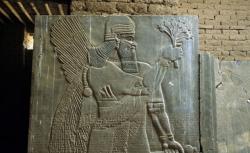 Arbil - Archeologists working in northern Iraq have discovered a new Assyrian site in the vicinity of the historic Arbil city center, the head of the antiquities office in the Kurdish Province of Arbil, Haydar Hassan, was quoted as saying in an Iraqi newspaper. The Assyrian civilization flourished in northern Iraq between 1000-700 B.C., archeologists were led to discover the site when they exhumed a burial ground, complete with mud brick grave heads. To further unearth this site the foreign archeological team had to study and remove two more layers of civilization under which the Assyrian structure was buried, according to a report published by Iraq’s al-Zaman on Monday. The excavations have shown that the Assyrian graves were covered by remains belonging to the Sassanid Persian Dynasty that ruled Iraq before being dislodged by Muslim Arab tribes from the Arabian desert in the 7th century A.D., said Haydar Hassan. So far only the brick arches and corridors of the Assyrian layer have been brought to the surface. Although archaeological teams from Italy, the U.S., Germany, Holland, Poland and Greece are currently working in northern Iraq, Hassan did not say which foreign archaeologists were working on the newly discovered Assyrian site in Arbil.
Arbil - Archeologists working in northern Iraq have discovered a new Assyrian site in the vicinity of the historic Arbil city center, the head of the antiquities office in the Kurdish Province of Arbil, Haydar Hassan, was quoted as saying in an Iraqi newspaper. The Assyrian civilization flourished in northern Iraq between 1000-700 B.C., archeologists were led to discover the site when they exhumed a burial ground, complete with mud brick grave heads. To further unearth this site the foreign archeological team had to study and remove two more layers of civilization under which the Assyrian structure was buried, according to a report published by Iraq’s al-Zaman on Monday. The excavations have shown that the Assyrian graves were covered by remains belonging to the Sassanid Persian Dynasty that ruled Iraq before being dislodged by Muslim Arab tribes from the Arabian desert in the 7th century A.D., said Haydar Hassan. So far only the brick arches and corridors of the Assyrian layer have been brought to the surface. Although archaeological teams from Italy, the U.S., Germany, Holland, Poland and Greece are currently working in northern Iraq, Hassan did not say which foreign archaeologists were working on the newly discovered Assyrian site in Arbil.
http://english.alarabiya.net/articles/2012/10/02/241427.html
BULGARIE – 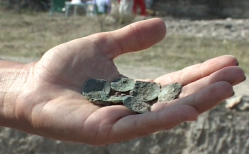 Veliki Preslav - Archaeologists working at the site of a medieval monastery in Veliki Preslav, one of the former capitals of Bulgaria, have found 101 copper coins said to date from the late 12th to early 13th centuries CE. Preslav was the capital of the First Bulgarian Kingdom from 893 to 972 CE. The site is about 20km from the town of Shoumen in north-easternBulgaria. The coins bear the images of Byzantine emperors Isaac II Angelos, who reigned from 1185 to 1195, and Alexios III Angelos, whose reign was from 1195 to 1203. They were found in the north-east corner of the monastery building, which dates to the ninth century. The coins were found over a space of four hours, after the first batch was located by a metal detector. Professor Kazimir Popkonstantinov said that a find of such a large amount of coins was unprecedented for the Preslav archaeological site.
Veliki Preslav - Archaeologists working at the site of a medieval monastery in Veliki Preslav, one of the former capitals of Bulgaria, have found 101 copper coins said to date from the late 12th to early 13th centuries CE. Preslav was the capital of the First Bulgarian Kingdom from 893 to 972 CE. The site is about 20km from the town of Shoumen in north-easternBulgaria. The coins bear the images of Byzantine emperors Isaac II Angelos, who reigned from 1185 to 1195, and Alexios III Angelos, whose reign was from 1195 to 1203. They were found in the north-east corner of the monastery building, which dates to the ninth century. The coins were found over a space of four hours, after the first batch was located by a metal detector. Professor Kazimir Popkonstantinov said that a find of such a large amount of coins was unprecedented for the Preslav archaeological site.
http://sofiaglobe.com/2012/10/03/archaeology-101-medieval-coins-found-at-monastery-site-in-bulgarias-former-capital-preslav/
USA – Troy - A significant archaeological discovery of Mohican artifacts in the South Troy Industrial Park has led to discussions between the city and the Stockbridge-Munsee Community Band of Mohican Indians in Wisconsin to establish a research center. "The Mohicans' presence in Troy was very strong, and we are in the early part of the process in looking at future plans for this historically significant area," Rosamilia said. The Mohicans were contacted after exploration along the road site revealed that their ancestors had been there. "We did the archaeology. There was a very significant Mohican site uncovered," Russ Reeves, the city engineer, said. "It turned out to be prolific in terms of ceramics and all sorts of interesting artifacts." Mohican-related materials have been recovered from other sites near the Hudson River. This portion of the Capital Region is considered part of the Mohican's historic territory.
http://www.timesunion.com/local/article/Mohican-artifacts-uncovered-at-site-3914066.php
FRANCE – 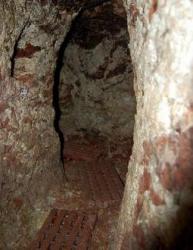 Sublaines - Entre juillet et septembre 2012, plusieurs chantiers de fouilles archéologiques ont été menés à Sublaines par l'INRAP dans le cadre de la création de la zone artisanale par la CCBV Sublaines-Bois-Gaulpied. Parmi les vestiges de la période médiévale, un souterrain-refuge du Moyen Age, entièrement conservé, a été mis à jour. « Une découverte rare dans le cadre de fouilles préventives tout autant que son exceptionnel état de conservation », exprimait Séverine Chaudriller. Après la découverte d'un pot à cuire en céramique et l'étude d'un céramologue, il a été rapidement permis d'attester une occupation de ce souterrain bien antérieure à la fin du XIe siècle. A cette époque, des querelles opposaient les maisons centrales d'Anjou et de Blois pour l'appropriation de la Touraine, où un important maillage d'édifices « militaires » avait été construit. Constitué d'un réseau de couloirs et de différentes salles, le souterrain découvert se développe sur plus de 15 m linéaires. Etroit et bas (50 cm de large en moyenne pour une hauteur de 1,15 à 1,55 m), il devait servir à la fois de refuge, comme en attestent les « coudes » à angle droit ainsi que la présence de deux portes (une à l'entrée du souterrain, une encastrée dans le calcaire) permettant de se dissimuler et de freiner l'assaillant. Ou servir également de lieu de stockage en protégeant les denrées des pillards. On trouve également un petit puits à eau taillé dans le calcaire et alimenté par la nappe phréatique ainsi que vingt niches destinées aux lampes à l'huile. Des bancs taillés à même le calcaire démontrent que le refuge devait être parfois occupé de manière prolongée. Il est estimé que cette excavation pouvait accueillir une famille de cinq à six personnes. Ce souterrain pouvait parfaitement servir de refuge à une élite locale et être la propriété particulière d'un Seigneur. A l'intérieur, on peut relever également un nombre important de marques d'outils encastrés dans les parois. Les post-fouilles qui vont maintenant être menées permettront d'affiner la connaissance et la compréhension de cette occupation médiévale. Un rapport sera rendu d'ici deux ans.
Sublaines - Entre juillet et septembre 2012, plusieurs chantiers de fouilles archéologiques ont été menés à Sublaines par l'INRAP dans le cadre de la création de la zone artisanale par la CCBV Sublaines-Bois-Gaulpied. Parmi les vestiges de la période médiévale, un souterrain-refuge du Moyen Age, entièrement conservé, a été mis à jour. « Une découverte rare dans le cadre de fouilles préventives tout autant que son exceptionnel état de conservation », exprimait Séverine Chaudriller. Après la découverte d'un pot à cuire en céramique et l'étude d'un céramologue, il a été rapidement permis d'attester une occupation de ce souterrain bien antérieure à la fin du XIe siècle. A cette époque, des querelles opposaient les maisons centrales d'Anjou et de Blois pour l'appropriation de la Touraine, où un important maillage d'édifices « militaires » avait été construit. Constitué d'un réseau de couloirs et de différentes salles, le souterrain découvert se développe sur plus de 15 m linéaires. Etroit et bas (50 cm de large en moyenne pour une hauteur de 1,15 à 1,55 m), il devait servir à la fois de refuge, comme en attestent les « coudes » à angle droit ainsi que la présence de deux portes (une à l'entrée du souterrain, une encastrée dans le calcaire) permettant de se dissimuler et de freiner l'assaillant. Ou servir également de lieu de stockage en protégeant les denrées des pillards. On trouve également un petit puits à eau taillé dans le calcaire et alimenté par la nappe phréatique ainsi que vingt niches destinées aux lampes à l'huile. Des bancs taillés à même le calcaire démontrent que le refuge devait être parfois occupé de manière prolongée. Il est estimé que cette excavation pouvait accueillir une famille de cinq à six personnes. Ce souterrain pouvait parfaitement servir de refuge à une élite locale et être la propriété particulière d'un Seigneur. A l'intérieur, on peut relever également un nombre important de marques d'outils encastrés dans les parois. Les post-fouilles qui vont maintenant être menées permettront d'affiner la connaissance et la compréhension de cette occupation médiévale. Un rapport sera rendu d'ici deux ans.
http://www.lanouvellerepublique.fr/Indre-et-Loire/communes/Sublaines/n/Contenus/Articles/2012/09/28/Des-fouilles-revelent-un-souterrain-refuge
TURQUIE –  - Heraklia / Latmos - Thousands of rock carvings discovered at the beginning of the 1990s in the ancient city of Heraklia at Latmos in southwestern Turkey are faced with destruction due to plans to open a stone quarry at the site. At the beginning of the '90s, many rock carvings were discovered at the Five Finger Mountains in research by Dr. Anneliese Peschlow-Bindokat from the German Archaeological Institute. The carvings have been dated to the sixth to fifth centuries B.C., and are considered one of the most significant discoveries of Near Eastern archaeology. However, seven feldspar stone quarries have been opened in the vicinity to meet the demand for raw material to be used in the production of glass, ceramics and in the dye industry in recent years. There are now new plans to opening further quarries close to the site where most of the carvings are located. According to the Radikal daily, Peschlow is now preparing a report for the United Nations Educational, Scientific and Cultural Organization (UNESCO) and the Muğla and Aydın Board of Cultural and Natural Heritage to save the area from destruction. Perschlow stated that the carvings reflect the phases through which humanity has passed. “Labraunda, one of the outstanding ancient cities in the southern west, has lost its glamor for the same reason. We must do our best to prevent the destruction of this site; otherwise this unique prehistory open air museum will be lost,” said Perschow. Peschlow pointed out that the women were portrayed as very significant in the carvings, and that they reflect themes of community, family and male/female relations.
- Heraklia / Latmos - Thousands of rock carvings discovered at the beginning of the 1990s in the ancient city of Heraklia at Latmos in southwestern Turkey are faced with destruction due to plans to open a stone quarry at the site. At the beginning of the '90s, many rock carvings were discovered at the Five Finger Mountains in research by Dr. Anneliese Peschlow-Bindokat from the German Archaeological Institute. The carvings have been dated to the sixth to fifth centuries B.C., and are considered one of the most significant discoveries of Near Eastern archaeology. However, seven feldspar stone quarries have been opened in the vicinity to meet the demand for raw material to be used in the production of glass, ceramics and in the dye industry in recent years. There are now new plans to opening further quarries close to the site where most of the carvings are located. According to the Radikal daily, Peschlow is now preparing a report for the United Nations Educational, Scientific and Cultural Organization (UNESCO) and the Muğla and Aydın Board of Cultural and Natural Heritage to save the area from destruction. Perschlow stated that the carvings reflect the phases through which humanity has passed. “Labraunda, one of the outstanding ancient cities in the southern west, has lost its glamor for the same reason. We must do our best to prevent the destruction of this site; otherwise this unique prehistory open air museum will be lost,” said Perschow. Peschlow pointed out that the women were portrayed as very significant in the carvings, and that they reflect themes of community, family and male/female relations.
http://www.todayszaman.com/mainAction.action
FRANCE – 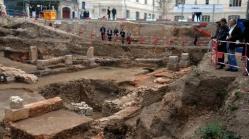 Poitiers - Les spécialistes ont découvert sur les 750 m du site une nouvelle voie romaine (décumanus) inconnue jusqu'alors. Au Haut-Empire (milieu du II/III siècles après JC), elle est large de 7,50 m et bordée de colonnades supportant probablement des murs de façade. Celui du nord semble donner sur une cour ou sur un jardin, alors que celui du sud longe le péristyle d'une riche demeure (domus) ouvrant en contrebas sur un jardin. C'est cet endroit que le nymphée découvert en juin à l'angle des rues Lebacles et Puygarreau décorait. Au Bas-Empire (fin III, début IV siècles) une voie plus étroite de 4 mètres est aménagée au même endroit. « C'est l'époque ou la ville de Poitiers déborde du plateau pour descendre vers la rivière », analyse M. Gerber. Cette voie s'installe sur les remblais de démolition du quartier antique et sur un talus (ager) appuyé contre le rempart datant du Bas-Empire. Une cave de l'époque mérovingienne (X siècle) suscite également l'intérêt: « elle est de la même époque que celle découverte aux Caillons, au bout de la Grand'rue », indique l'archéologue. Les fouilles terminées, le site sera recouvert pour laisser la place aux travaux des futurs jardins publics.
Poitiers - Les spécialistes ont découvert sur les 750 m du site une nouvelle voie romaine (décumanus) inconnue jusqu'alors. Au Haut-Empire (milieu du II/III siècles après JC), elle est large de 7,50 m et bordée de colonnades supportant probablement des murs de façade. Celui du nord semble donner sur une cour ou sur un jardin, alors que celui du sud longe le péristyle d'une riche demeure (domus) ouvrant en contrebas sur un jardin. C'est cet endroit que le nymphée découvert en juin à l'angle des rues Lebacles et Puygarreau décorait. Au Bas-Empire (fin III, début IV siècles) une voie plus étroite de 4 mètres est aménagée au même endroit. « C'est l'époque ou la ville de Poitiers déborde du plateau pour descendre vers la rivière », analyse M. Gerber. Cette voie s'installe sur les remblais de démolition du quartier antique et sur un talus (ager) appuyé contre le rempart datant du Bas-Empire. Une cave de l'époque mérovingienne (X siècle) suscite également l'intérêt: « elle est de la même époque que celle découverte aux Caillons, au bout de la Grand'rue », indique l'archéologue. Les fouilles terminées, le site sera recouvert pour laisser la place aux travaux des futurs jardins publics.
http://www.centre-presse.fr/article-211672-derniere-ligne-droite-pour-br-les-fouilles-de-puygarreau.html
FRANCE– 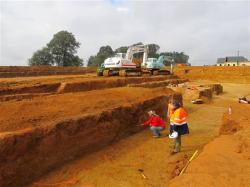 Beslan - Le site est le dernier des neufs chantiers de fouilles archéologiques préventives effectuées au nord du Mans sur le tracé de la ligne LGV. Ce nouveau chantier de fouilles s’inscrit dans la continuité des travaux effectués en début d’année sur le site voisin des Rochardières. « Dans les fouilles précédentes, on était en présence d’un schéma classique : des puits étaient creusés avec des galeries. Ici, on a l’impression que les puits sont des ascenseurs qui desservaient des étages. On cherche à savoir comment nos ancêtres organisaient leur travail », note Véronique Gallien, responsable du chantier. Jean-Yves Langlois, adjoint scientifique et technique à l’Inrap, nous présente ce chantier.
Beslan - Le site est le dernier des neufs chantiers de fouilles archéologiques préventives effectuées au nord du Mans sur le tracé de la ligne LGV. Ce nouveau chantier de fouilles s’inscrit dans la continuité des travaux effectués en début d’année sur le site voisin des Rochardières. « Dans les fouilles précédentes, on était en présence d’un schéma classique : des puits étaient creusés avec des galeries. Ici, on a l’impression que les puits sont des ascenseurs qui desservaient des étages. On cherche à savoir comment nos ancêtres organisaient leur travail », note Véronique Gallien, responsable du chantier. Jean-Yves Langlois, adjoint scientifique et technique à l’Inrap, nous présente ce chantier.
VIDEO = http://www.lemans.maville.com/actu/actudet_-[Video]-La-Milesse.-LGV-nouveau-chantier-de-fouilles-archeologiques-a-Beslan_fil-2220304_actu.Htm